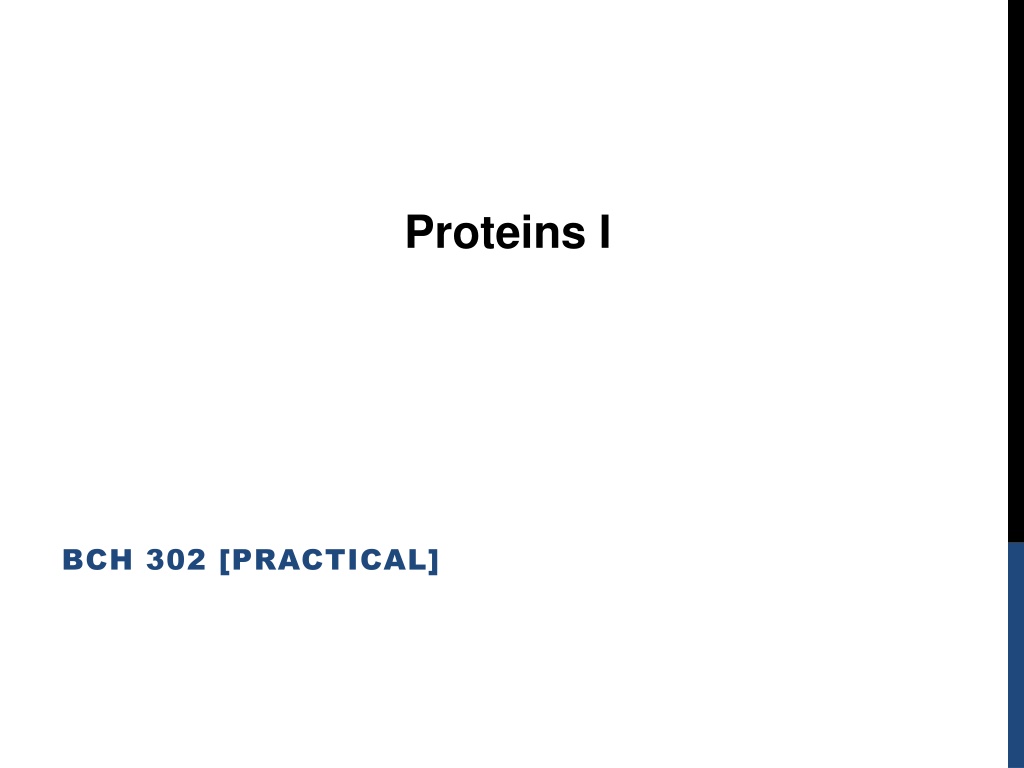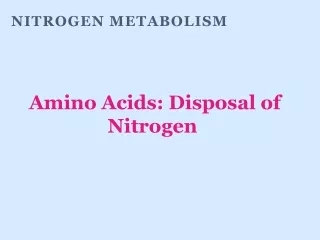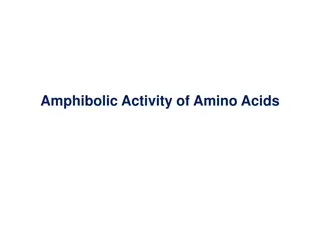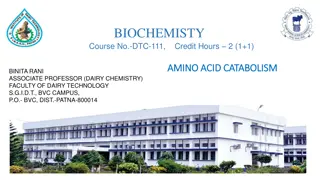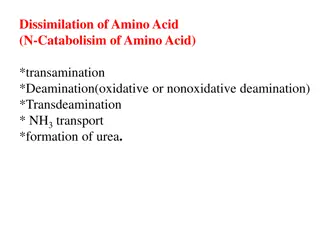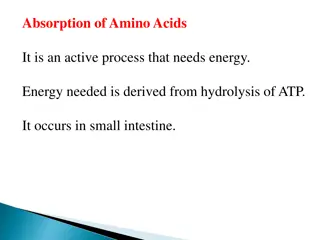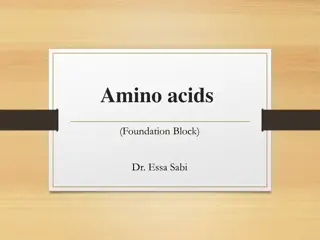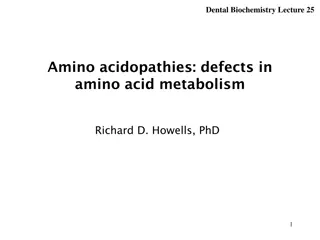Qualitative Chemical Reactions of Amino Acid Protein Functional Groups
Qualitative chemical reactions of amino acid protein functional groups involve detecting the presence of peptides (proteins) in a sample through tests like the Biuret test. Different reactions, such as the effect of salt concentration on protein solubility and precipitation of proteins by acids, help in understanding protein properties and behaviors in various conditions.
Download Presentation

Please find below an Image/Link to download the presentation.
The content on the website is provided AS IS for your information and personal use only. It may not be sold, licensed, or shared on other websites without obtaining consent from the author. Download presentation by click this link. If you encounter any issues during the download, it is possible that the publisher has removed the file from their server.
E N D
Presentation Transcript
Proteins I BCH 302 [PRACTICAL]
Qualitative chemical reactions of amino acid protein functional groups: -Certain functional groups in proteins can react to produce characteristically colored products. -The color intensity of the product formed by a particular group varies among proteins in proportion to the number of reacting functional or free groups present and their accessibility to the reagent.
Biuret test: Objective: detect the presence of peptides [proteins] in a sample. Principle: When a solution of proteins is treated with cupric ions (Cu2+) in a moderately alkaline medium, a purple colored [Cu2+ - peptide] complex is formed.
protein [containing peptide bounds] Biuret complex purple
Note: 1.This test is specific for the peptide bond. 2. Positive result(purple color) will given if the substance have two or more peptide bonds (three or more amino acids) 3. biuret reagent is alkaline copper sulfate solution.
In this lab we will test the followings: 1.Effect of salt concentration on the protein solubility. 2.Precipitation of proteins by acids. 3. Precipitation of protein by salts of heavy metals. 4. Protein denaturation.
1.Effect of salt concentration on the protein solubility: Objective: to investigate the effect of different salt concentration on protein solubility. Principle: -When the solubility of proteins increased in low concentration of salts it called salting in. Salt molecules stabilize protein molecules by decreasing the electrostatic energy between the protein molecules which increase the solubility of proteins. -when the proteins precipitate at high concentration of salts it called Salting out. The salt molecules compete with the protein molecules in binding with water. Note: Each protein can be precipitated at specific salt concentration.
2.Precipitation of proteins by acids: Objective: To investigate the effects of strong acids on the protein solubility. Principle: This test depend on affecting solubility of the protein as a function of changes in pH. In highly acidic media, the protein will be positively changed, which is attracted to the acid anions that cause them to precipitate. Applications: -Separation and purification. -Detection of small amount of protein in urea sample. - Stop the enzyme reaction.
Precipitation of albumin using Trichloroacetic acid [TCA] Precipitation of albumin using concentrated nitric acid.
3. Precipitation of protein by salts of heavy metals: Objective: to identify the effect of heavy metal salt on protein. -Heavy metal salts usually contain Hg+2, Pb+2, Ag+1 Tl+1, Cd+2 and other metals with high atomic weights. Since salts are ionic they disrupt salt bridges in proteins. The reaction of a heavy metal salt with a protein usually leads to an insoluble metal protein salt. Principle: -Heavy metal salt will neutralize the protein: By the negative charge of protein will bind with positive charge of metal ion . Then the protein will precipitate as insoluble metal protein salt . Application: To eliminate the poisoning by palladium Pb++ ,......mercury salts Hg++
4. Protein denaturation: Objective: to investigate the effect of high temperature on protein structure. Principle: Non-covalent bond can be broken by heating, leading to protein denaturation and the precipitation. Denaturation is a major change from the original native state without alteration of the molecule's primary structure, i.e., without cleavage of any of the primary chemical bonds that link one amino acid to another.
Denaturation of Proteins: Denaturation is a process in which the proteins losing its quaternary structure, tertiary structure and secondary structure, by application of some external factor or compound such as a strong acid or base, a conc. inorganic salt, an organic solvent (e.g., alcohol or chloroform), or heat. Denaturation Factors: Heat , inorganic salt , organic solvent , irradiation ,strong acid ,
